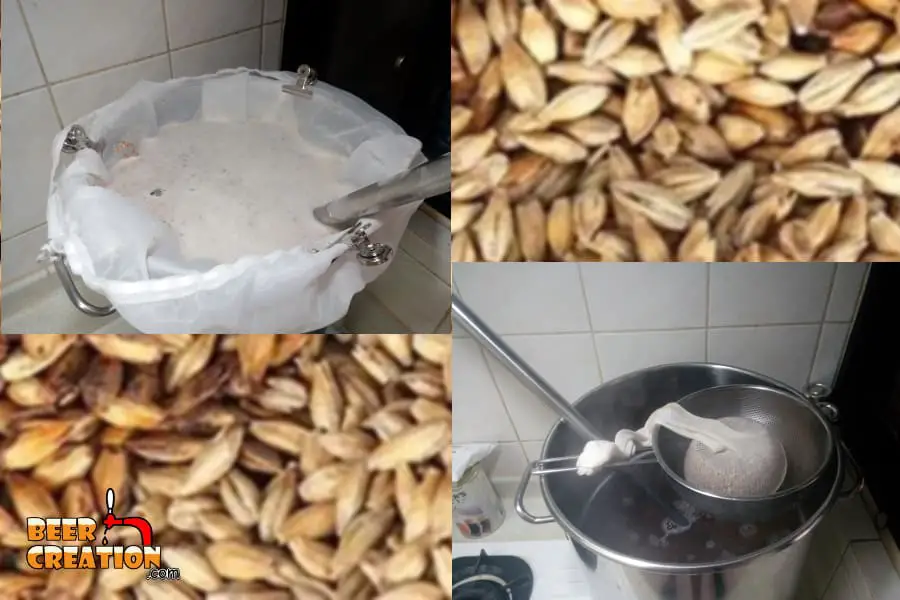As a new homebrewer, you’re going to find out that beer is a heck of a lot more complex than you first thought, and the processes to do with making it are no different.
There are a lot of phrases thrown around the brewery and mashing and steeping are just two of them. These sound like very similar processes when you first hear about mashing and steeping.
While both involve the soaking of crushed grains in water, when you look at them more closely, there are some big differences between the two methods. In fact, each one is used in very different ways to achieve different qualities in a finished beer, which I’ll explain now.
Mashing is where soaked malted grains are heated to extract fermentable sugars from the natural starches. Steeping is a process using specialty grains for releasing colors, aroma, & flavors into the wort. The main difference is the thickness, temperature, duration, & method used to treat the grains.
Those were just brief definitions of the major difference between steeping and mashing. There are a lot more details and nuances that you should know before you carry out either of these processes.
I just want to outline more detail on how each of these processes works and how to use them in your own recipes, so read on to learn more and become an even better brewer.
What is mashing?

Mashing is the first step in all-grain brewing, and if you are working with liquid or dry malt extract (LME, DME), it’s probably not something you’ll need to do. More on that later.
The goal of mashing is to soak malted grains in water at a temperature high enough (usually around 154°F) to activate naturally occurring enzymes found in it. This is normally done for about an hour, but when you hit your target original gravity (the amount of sugar in your wort) you can actually stop mashing earlier.
These enzymes, amylase enzymes, then convert the starches in the grains into fermentable sugars. You can change the level of fermentable sugars in your wort by using different types of grains and mashing at different temperatures.
There are different types of mashing methods using different combinations of grains. Basically, the main method is that you combine the malts that are high in enzymes with starchy grains, and those lack enzymes. Different ways of mashing may only use malted grains.
Other mashing methods use adjuncts. Rice and or corn are adjuncts that work because enzymes from the malt can move with ease in the mash once the malt has been crushed and soaked.
The amylase enzymes cannot tell the difference between the starch and the malt and or rice. The enzymes break down (hydrolyzing) the starch into fermentable sugars. However, some adjuncts aren’t actually added to produce more sugars, but rather to add other compounds for other qualities, such as head retention or mouthfeel.
This being said, the main goal of mashing, that the starch is broken down into fermentable sugars. The grains that you mash will vary depending on what type of beer you are trying to make most often the grains that are used are any pale malt, lightly toasted or kilned special malts, and raw cereal grains.
Different types of mashing techniques
It’s more than likely that you, as a homebrewer, are going to use infusion mashing but there is such a thing as decoction mashing too.
Infusion mashing is by far the simplest and most popular way of mashing your grain bill. Basically, you put in all your grain bill together, heat it up to the right temperature, and then go onto lauter and sparge it as a whole.
Decoction mashing is a little more popular in places like Germany and other European countries with similar traditions. It involves mashing smaller quantities of the grain bill separately before adding them together, raising the temperature, and even drawing the mash off again to repeat the process.
By doing this, the cell walls of the grain are broken down more and maltier flavors can be extracted into the beer. The process of decoction can be carried out as many times as the brewer wants, but around three steps are quite normal.
New to homebrewing? Please feel free to read my ultimate guide to brewing beer at home and where to start.
Where to mash your grains?
If you are embarking on your first all-grain brewing experience, firstly you’re going to love the feeling, and secondly, you need to decide how you want to mash.
You can easily mash in a separate container which is designed to help you extract as much sugar as you can through the mashing and later sparging process. This is called a mash tun.
Alternatively, you can mash your grains in the same container, brew kettle, that you plan to boil the beer in later. You can do this by following the Brew in A Bag principle (BIAB) and use a brewer’s bag to hold the grain bill in which you can later remove wholesale.
For more details on these choices, check out my more in-depth article here.
What is steeping?
So, as I said before, mashing is part of the all-grain brewing process. Steeping, on the other hand, is something that is done by extract brewers, especially if using an extract kit. Whereas mashing can take up to and more than 60 minutes, steeping usually is only recommended for about 20 minutes before then boiling the wort.
Stepping is the method in which you extract colors and flavors from different types of special grains. The grains are again heated in warm water, but the enzymes won’t be acting on the starch to extract much sugar if any at all. In fact, these types of grains are often only added to the grain bill for aesthetic and tasting reasons.
So as I said, steeping is to extract the compounds contained in the malt. Steeping uses specialty malts, which are types of malts that have already had the starch converted into sugar during the malting process.
Types of specialty grains
Caramelized malts
Crystal, caramel malts, grains, or any malt that has been subject to high levels of heat so that the starch is modified and the malt enzymes won’t change them.
Non-caramelized Malts
These types of roasted grains and malts often include (but not limited to) chocolate/ black malt, roasted wheat, roasted wheat malt, roasted rye, and roasted barley. You may not want to use these malts and grains because they have a lot of starch in them, like Munich malts, pale wheat malt, pale rye malt, barley, oats, corn, and rice.
Do you usually mash and steep grains?
It’s very unlikely that you will ever mash and then steep grains. This is purely because of the processes involved.
When you are brewing an all-grain recipe you will always have a combination of your base malts which are the backbone of your beer with these specialty malts which give it its distinct character. The only exception I can think of is with SMaSH beers (Single Malt and Single Hops).
Steeping is used in extract brewing because with these kits and recipes we are using a generic liquid or dry malt extract (LME, DME). It’s normally either a lighter or darker malt that has already been mashed and then reduced into a syrup (or powder in the case of DME) that brewers can use later on.
So because the LME or DME is only really a base malt, we need to steep some specialty malt in our brewing water, before you add the LME or DME, to give it a bit of that special character we want for the beer style.
Shop for your brewing ingredients online at homebrewing.org
What are the key differences?
Apart from when we do it, there are some differences between the two processes of mashing and steeping.
The key differences in the actual processes of steeping and mashing are thickness, temperature, duration, and the methods that are used to separate the grains from the liquid. The thickness is not outlined below as it is part of each of the steps and cannot be talked about by itself but only seen in the final product.
Fluid Ratio
Mash- Mash thickness or malt to water ratio is important and different from steeping. The ratio of water to mash is usually 1-2 quarts of water per pound of malt. See my article for more details.
Steeping- Stepping, on the other hand, is a bit different and we usually get thinner consistency like tea. There’s much higher water to malt ratio. A commonly used ratio would 4-6 quarts per pound of malt.
Temperature
Mash- The enzymes in the mash are affected by the concentration of starch. Too high and the amylase enzymes will lack the water needed to hydrolyze starch (break the chemical bond). Too thin, the enzymes are less heat-stable and can be destroyed. There are different types of names for the mash rests e.g enzymes; acid or phosphatase rest, beta-glucanase rest, protein rest, fermentability rest, the conversion rest, and the mash-off step.
All of their temperatures will vary on the different types of malts you will use and what you are trying to achieve. But a quick guide would be when using base grains, or a combination of base grains and specialty grains, between 145°F and 165°F would be safe.
If you aren’t sure how to measure the temperature best, check out my article here about the best types of brewing thermometers on the market.
Hot Steeping- There is no real jargon like there is of the mash and it is a bit simpler of a process. When you are hot steeping you want to keep the steep temperature below 170 °F. The reason for this is so you can avoid the extraction of tannins from the malt husk.
Cold Steeping- Most people think that there is only hot steeping, but cold steeping is another method that is gaining popularity in the homebrewing community.
While it is the same concept think of this as a similar process to cold brew coffee. In cold steeping, you get your special roasted grains or malt that are crushed and then steep them in cold water overnight. This way it will extract some of the color and flavor, but it can also reduce some of the stronger flavors that are not desirable like tannins.
Tannins give your beer a bitter taste that is not often wanted. More often than not, this type of steeping is done for more color and to remove the harshness, if you want the flavor as well, you will have to greatly increase the steeping time by at least half.
Timing and Method
Mash- For the reaction to take place in most mashes it will be at a minimum of an hour and usually up to ninety minutes. This process requirement is more involved than steeping and needs to separate the wort from the grain bed, which is called lautering and sparging.
The wort is separated from the solids in your strainer like a lauter tun and then would be rinsed thoroughly with hot water to extract all of the fermentable sugars possible. This step is needed for the thickness of the wort.
If you don’t sparge well enough, the specific gravity of the wort could be off from if you did. How to sparge and how not to sparge is up for debate, see what works best for you.
Steeping- Hot steeping does not need as long as mashing does since the only thing that is happening is that the malt solids are dissolving.
You can do this all in about 15 -20 minutes. Then you want to separate the grain from the liquid. This is much easier when you steep in a small muslin or brewer’s nylon bag, like a giant teabag. I’ve even heard of brewers using a clean cotton sock to do this. You can then rinse the bag with hot water as well depending on your recipe.
What grains can be steeped?
There are two types of grain that people use to steep, specialty grains and regular malt grains. All the grain is similar in that you basically just toss them in a bag and steep them, but do read the directions for each first or talk to the staff in your local homebrewing supply shop (see my article for more details).
As you gain more experience in homebrewing you can experiment with different combinations of grains. So, do read up on each one as they all have special properties that can greatly affect the look and taste of the beer.
When choosing a malt you do not want these to have starchy interiors. If they do the staches will have been converted to sugars. I have included a list below but there are more out there, just do your research.
- Stewed malts – These are crystal malts, almost all caramel malts, most Cara malts, and Special B malts
- Roasted malts/grains – These can include black, chocolate, roasted barley, and dark wheat
- Peat smoked malts
What malts can be mashed?
As opposed to the steeping you want these malts to contain starchy interiors and enough enzymes to at least convert their own starches into sugar (but this isn’t usually an issue).
Here is a quick list of some of the malts that you can buy pretty easily in the States and use to mash, make sure you read up on each before processing.
- 2-row brewers malt
- 6-row pale malt
- Pilsner malt
- Vienna malt
- Munich malt
- wheat malt
- rye malt
- mild ale malt
- amber malt
- brown malt
- honey malt
How much water do you need for mashing or steeping?
As I mentioned before, you will need certain amounts of water to get the right thickness and consistency when mashing or steeping grain. You will also need additional water to sparge a mash.
For more information on this, why not go over and check out my much more detailed article all about how much water you need for brewing beer.






